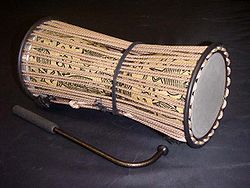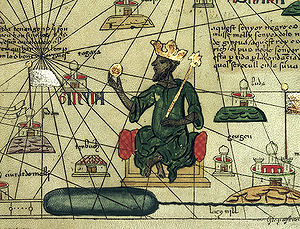West Africa
From Wikipedia, the free encyclopedia
West Africa or Western Africa is the westernmost region of the African continent. Geopolitically, the UN definition of Western Africa includes the following 16 countries distributed over an area of approximately 5 million square km:[1]
With the exception of Mauritania, all of these countries are members of the ECOWAS or Economic Community of West African States. The UN region also includes the island of Saint Helena, a British overseas territory in the South Atlantic Ocean.
Contents |
[edit] Background
West Africa is oriented west of an imagined north-south axis lying close to 10° east longitude. The Atlantic Ocean forms the western and southern borders of the region. The northern border is the Sahara Desert, with the Niger Bend generally considered the northernmost part of the region. The eastern border is less precise, with some placing it at the Benue Trough, and others on a line running from Mount Cameroon to Lake Chad.
Colonial boundaries are reflected in the modern boundaries between contemporary West African nations, cutting across ethnic and cultural lines, often dividing single ethnic groups between two or more countries.
The inhabitants of West Africa are, in contrast to most of Sub-Saharan Africa, non-Bantu speaking peoples.
[edit] Geography and climate
West Africa, if one includes the western portion of the Maghreb (Western Sahara, Morocco, Algeria, and Tunisia), occupies an area in excess of 6,140,000 km2, or approximately one-fifth of Africa. The vast majority of this land is plains lying less than 300 meters above sea level, though isolated high points exist in numerous countries along the southern shore of the region.
The northern section of West Africa is composed of semi-arid terrain known as Sahel, a transitional zone between the Sahara desert and the savannahs of the western Sudan forests form a third belt between the savannas and the southern coast, ranging from 160 km to 240 km in width.
[edit] Culture and religion

Despite the wide variety of cultures in West Africa, from Nigeria through to Senegal, there are general similarities in dress, cuisine, music and culture that are not shared extensively with groups outside the geographic region. Islam is the predominant historical religion of the West African interior and the far west coast of the continent; Christianity is the predominant religion in coastal regions of Nigeria, Ghana, and Cote d'Ivoire; and elements of indigenous religions are practiced throughout. Before the decline of the Mali and Songhai Empires there was a sizable group of Jewish communities in areas like Mali, Senegal, Mauritania, and Nigeria. Today there are small Jewish populations in Ghana, Nigeria and Mali. Along with historic migrations, these religions have culturally linked the peoples of West Africa more than those in other parts of Sub-Saharan Africa.
The game Oware is quite popular in many parts of West Africa. Soccer is also a pastime enjoyed by many, either spectating or playing. The national teams of some West African nations, especially Nigeria, Ghana and the Ivory Coast, regularly qualify for the World Cup.
Mbalax, Highlife, Fuji and Afrobeat are all modern musical genres which enjoin listeners in this region. Traditionally, musical and oral history as conveyed over generations by Griots are typical of West African culture.
A typical formal attire worn in this region is the flowing Boubou (also known as Agbada and Babariga), which has its origins in the clothing of nobility of various West African empires in the 12th century.
The Djembe drum, whose origins lie with the Mandinka peoples, is now a popularly played drum among many West African ethnic groups. The Kora is a 21-string harp-lute of Mandinkan origin, played by various groups in the region. The Djembe, Kora, the silk Kente cloth of the Akan peoples of Ghana and the distinct Sudano-Sahelian architectural style seen in the many mosques of the region (see Djenné), are the primary symbolic icons of West African culture.
[edit] History
The history of West Africa can be divided into five major periods: first, its prehistory, in which the first human settlers arrived, developed agriculture, and made contact with peoples to the north; the second, the Iron Age empires that consolidated both intra-African, and extra-African trade, and developed centralized states; third, Major polities flourished, which would undergo an extensive history of contact with non-Africans; fourth, the colonial period, in which Great Britain and France controlled nearly the whole of the region; fifth, the post-independence era, in which the current nations were formed.
[edit] Prehistory
Early human settlers, probably related to the Pygmies, arrived in West Africa around 12,000 B.C. Sedentary farming began in, or around the fifth millennium B.C, as well as the domestication of cattle. By 400 B.C, ironworking technology allowed an expansion of agricultural productivity, and the first city-states formed. The domestication of the camel allowed the development of a cross-Saharan trade with cultures across the Sahara, including Carthage and the Berbers; major exports included gold, cotton cloth, metal ornaments and leather goods, which were then exchanged for salt, horses, textiles, and other such materials. Local leather, cloth, and gold also contributed to the abundancy of prosperity for many of the following empires.
[edit] Empires
The development of the region's economy allowed more centralized states and civilizations to form, beginning with the Nok civilization which began 500 B.C. and the Ghana Empire in the 8th century AD which stretched to the Mali empire. Based around the city of Kumbi Saleh in modern-day Mauritania, the empire came to dominate much of the region until its defeat by Almoravid invaders in 1052. The Sosso Empire sought to fill the void, but was defeated (c. 1240) by the Mandinka forces of Sundiata Keita, founder of the new Mali Empire. The Mali Empire continued to flourish for several centuries (most particularly under Sundiata's grandnephew), Musa I before a succession of weak rulers led to its collapse under Mossi, Tuareg and Songhai invaders. In the fifteenth century, the Songhai would form a new dominant state based around Gao, in the Songhai Empire, under the leadership of Sonni Ali and Askia Mohammed. Further south, Osei Tutu and Okomfo Anokye have started to build the Empire of Ashanti Meanwhile, south of the Sudan, strong city states arose in Ife, Bono, and Benin around the fourteenth century. Further east, Oyo arose as the dominant Yoruba state and the Aro Confederacy as a dominant Igbo state in modern-day Nigeria.
[edit] Slavery and European contact

Following the 1591 destruction of the Songhai capital by Moroccan invaders, a number of smaller states arose across West Africa, including the Bambara Empire of Ségou, the Bambara kingdom of Kaarta, the Peul/Malinké kingdom of Khasso, and the Kénédougou Empire of Sikasso. Portuguese traders began establishing settlements along the coast in 1445, followed by the French and English; the African slave trade began not long after, which over the following centuries would debilitate the region's economy and population. The slave trade also encouraged the formation of states such as the Asante Empire, Bambara Empire and Dahomey, whose economies largely depended on exchanging slaves for European firearms, which were then used to capture more slaves.
The expanding Atlantic African slave trade produced significant populations of West Africans living in the New World, recently colonized by Europeans. The oldest known remains of African slaves in the Americas were found in Mexico in early 2006; they are thought to date from the late 16th century and the mid-17th century.[2] European and American governments passed legislation prohibiting the Atlantic slave trade in the 19th century, though slavery in the Americas persisted in some capacity through the century; the last country to abolish the institution was Brazil in 1888. Descendants of West Africans make up large and important segments of the population in Brazil, the Caribbean, Latin America, and the United States.
[edit] Colonialism
In the early nineteenth century, a series of Fulani reformist jihads swept across the Western Africa. The most notable include Usman dan Fodio's Fulani Empire, which replaced the Hausa city-states, Seku Amadu's Massina Empire, which defeated the Bambara, and El Hadj Umar Tall's Toucouleur Empire, which briefly conquered much of modern-day Mali. However, the French and British continued to advance in the Scramble for Africa, subjugating kingdom after kingdom. With the fall of Samory Ture's new-founded Wassoulou Empire in 1898 and the Ashanti queen Yaa Asantewaa in 1902, most West African military resistance to colonial rule came to an effective end.
Britain controlled The Gambia, Sierra Leone, Ghana, and Nigeria throughout the colonial era, while France unified Senegal, Guinea, Mali, Burkina Faso, Benin, Côte d'Ivoire and Niger into French West Africa. Portugal founded the colony of Guinea-Bissau, while Germany claimed Togoland, but was forced to divide it between France and Britain following First World War. Only Liberia retained its independence, at the price of major territorial concessions.
[edit] Postcolonial era
Following Second World War, nationalist movements arose across West Africa. In 1957, Ghana, under Kwame Nkrumah, became the first sub-Saharan colony to achieve its independence, followed the next year by France's colonies (Guinea in 1958 under the leadership of President Ahmed Sekou Touré); by 1974, West Africa's nations were entirely autonomous. Since independence, many West African nations have been plagued by corruption and instability, with notable civil wars in Nigeria, Sierra Leone, Liberia, and Côte d'Ivoire, and a succession of military coups in Ghana and Burkina Faso. Many states have failed to develop their economies despite enviable natural resources (see: Petroleum in Nigeria), and political instability is often accompanied by undemocratic government. AIDS is also a growing problem for the region, particularly in Côte d'Ivoire, Liberia, and Nigeria. Famine has been a problem in parts of northern Mali and Niger, the latter of which is currently undergoing a food crisis.
[edit] Conflicts
Until recently, most governments in West Africa were illiberal and corrupt and several countries have been plagued with political coups, ethnic violence and oppressive dictators. Since the end of colonialism, the region has been the stage for some of the most brutal conflicts ever to erupt. Among the latter are:
- Nigerian Civil War
- First Liberian Civil War
- Second Liberian Civil War
- Guinea-Bissau Civil War
- Ivorian Civil War
- Sierra Leone Civil War
Though a few countries like Ghana and Senegal have enjoyed relative stability and have even seen some growth, all progress in the region is contingent on the efficacy and justness of governance and the fair allocation of resources which, for the moment, both leave much to be desired.
[edit] Regional organizations
The Economic Community of West African States (ECOWAS), founded by the 1975 Treaty of Lagos, is an organization of West African states which aims to promote the region's economy. The West African Monetary Union (or UEMOA from its name in French, Union économique et monétaire ouest-africaine) is limited to the eight, mostly Francophone countries that employ the CFA franc as their common currency. The Liptako-Gourma Authority of Mali, Niger, and Burkina Faso seeks to jointly develop the contiguous areas of the three countries.
[edit] See also
- Atlantic slave trade
- French West Africa
- British West Africa
- 2004 locust outbreak
- Ashanti people
- Empire of Ashanti
- Fula people
- Ghana Empire
- Hausa people
- Igbo people
- Jews of the Bilad el-Sudan (West Africa)
- Mali Empire
- Mande people
- Manillas – A form of archaic money unique to West Africa
- Seedies and Kroomen
- Songhai Empire
- Western Sahara
- Yoruba people
[edit] References
- ^ The UN office for West Africa
- ^ "Skeletons Discovered: First African Slaves in New World". January 31, 2006. LiveScience.com. Retrieved on 2006-09-27.
[edit] External links
- West Africa by Region and Country – African Studies at Columbia University
- ouestaf.com – Online source for news and current affairs in west Africa.
- Loccidental – The News reference for West Africa.
- West Africa Review – An e-journal on West Africa research and scholarship.
|
|||||||||||||||||||||||||||||||||





